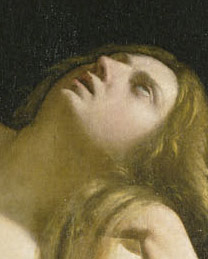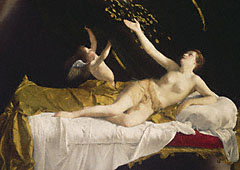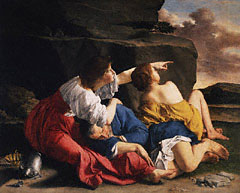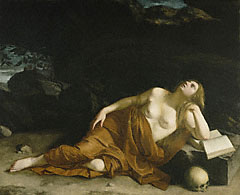| Education | ||
| Exhibitions | ||
| Explore Art | ||
| Research and Conservation | ||
| Bookstore | ||
| Games | ||
| About the J. Paul Getty Museum | ||
| Public Programs | ||
| Museum Home
|
October 1, 2002–January 12, 2003 at the Getty Center
The Italian painter Orazio Gentileschi (1563–1639) was the most innovative follower of Caravaggio (1571–1610), whose emphasis on realism and dramatic lighting revolutionized painting in the early 1600s. Gentileschi adopted Caravaggio's methods, including the practice of working directly from posed models, but he tempered realism with his own lyrical sense of beauty. |
||||||
At the Mercy of Fate In Greek mythology the beautiful Danaë was locked away in a sealed tower
by her father, the king of Argos, after an oracle prophesied that her son would
cause the king's death. Although mortal suitors could not reach Danaë,
Jupiter, king of the gods, transformed himself into a "shower of gold" to enter
the chamber and impregnate her. Danaë conceived the hero Perseus, who
eventually killed his grandfather by accident, affirming the belief in fate's
inevitability. |
||||||
A Moral Dilemma According to the Book of Genesis, God destroyed the sinful city of Sodom,
sparing only Lot and his daughters. Fearful that they alone survive to
perpetuate the human race, the daughters face a moral dilemma. Having
witnessed God's wrath for sin, should they obey his command to "be
fruitful and multiply," thereby committing incest? The daughters decide
to make their father drunk so that each can furtively mate with him. They
sought only to procreate, so their sin was not lust, but rather their lack
of love for God, for they did not trust that he would provide them children
without requiring incest. |
||||||
Redeemed by Divine Love In response to Protestant condemnation of the sacrament of penance, the Catholic Church promoted Mary Magdalen as the female model of the
repentant sinner redeemed by divine love. Notoriously wealthy and wanton in her early life, she abandoned physical pleasures to become one of Christ's most devoted followers. |
||||||



